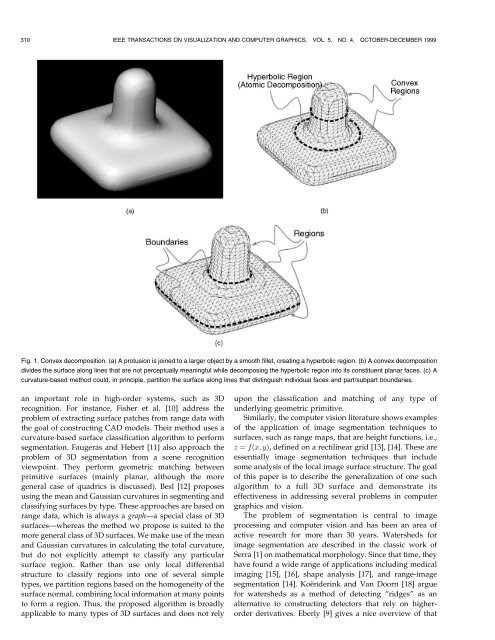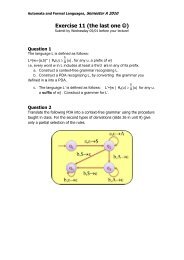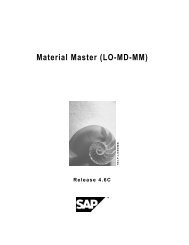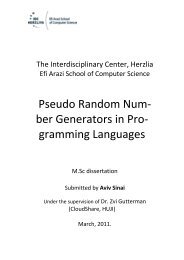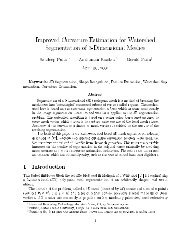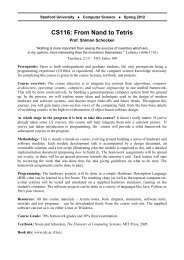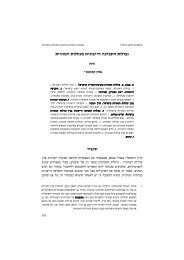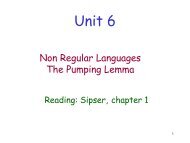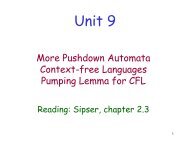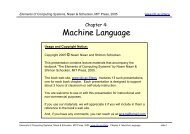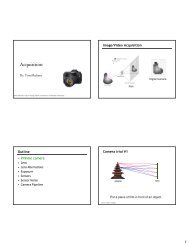Partitioning 3D Surface Meshes Using Watershed Segmentation
Partitioning 3D Surface Meshes Using Watershed Segmentation
Partitioning 3D Surface Meshes Using Watershed Segmentation
Create successful ePaper yourself
Turn your PDF publications into a flip-book with our unique Google optimized e-Paper software.
310 IEEE TRANSACTIONS ON VISUALIZATION AND COMPUTER GRAPHICS, VOL. 5, NO. 4, OCTOBER-DECEMBER 1999<br />
Fig. 1. Convex decomposition. (a) A protusion is joined to a larger object by a smooth fillet, creating a hyperbolic region. (b) A convex decomposition<br />
divides the surface along lines that are not perceptually meaningful while decomposing the hyperbolic region into its constituent planar faces. (c) A<br />
curvature-based method could, in principle, partition the surface along lines that distinguish individual faces and part/subpart boundaries.<br />
an important role in high-order systems, such as <strong>3D</strong><br />
recognition. For instance, Fisher et al. [10] address the<br />
problem of extracting surface patches from range data with<br />
the goal of constructing CAD models. Their method uses a<br />
curvature-based surface classification algorithm to perform<br />
segmentation. Faugeras and Hebert [11] also approach the<br />
problem of <strong>3D</strong> segmentation from a scene recognition<br />
viewpoint. They perform geometric matching between<br />
primitive surfaces (mainly planar, although the more<br />
general case of quadrics is discussed). Besl [12] proposes<br />
using the mean and Gaussian curvatures in segmenting and<br />
classifying surfaces by type. These approaches are based on<br />
range data, which is always a graphÐa special class of <strong>3D</strong><br />
surfacesÐwhereas the method we propose is suited to the<br />
more general class of <strong>3D</strong> surfaces. We make use of the mean<br />
and Gaussian curvatures in calculating the total curvature,<br />
but do not explicitly attempt to classify any particular<br />
surface region. Rather than use only local differential<br />
structure to classify regions into one of several simple<br />
types, we partition regions based on the homogeneity of the<br />
surface normal, combining local information at many points<br />
to form a region. Thus, the proposed algorithm is broadly<br />
applicable to many types of <strong>3D</strong> surfaces and does not rely<br />
upon the classification and matching of any type of<br />
underlying geometric primitive.<br />
Similarly, the computer vision literature shows examples<br />
of the application of image segmentation techniques to<br />
surfaces, such as range maps, that are height functions, i.e.,<br />
z ˆ f…x; y†, defined on a rectilinear grid [13], [14]. These are<br />
essentially image segmentation techniques that include<br />
some analysis of the local image surface structure. The goal<br />
of this paper is to describe the generalization of one such<br />
algorithm to a full <strong>3D</strong> surface and demonstrate its<br />
effectiveness in addressing several problems in computer<br />
graphics and vision.<br />
The problem of segmentation is central to image<br />
processing and computer vision and has been an area of<br />
active research for more than 30 years. <strong>Watershed</strong>s for<br />
image segmentation are described in the classic work of<br />
Serra [1] on mathematical morphology. Since that time, they<br />
have found a wide range of applications including medical<br />
imaging [15], [16], shape analysis [17], and range-image<br />
segmentation [14]. KoeÈnderink and Van Doorn [18] argue<br />
for watersheds as a method of detecting ªridgesº as an<br />
alternative to constructing detectors that rely on higherorder<br />
derivatives. Eberly [9] gives a nice overview of that


